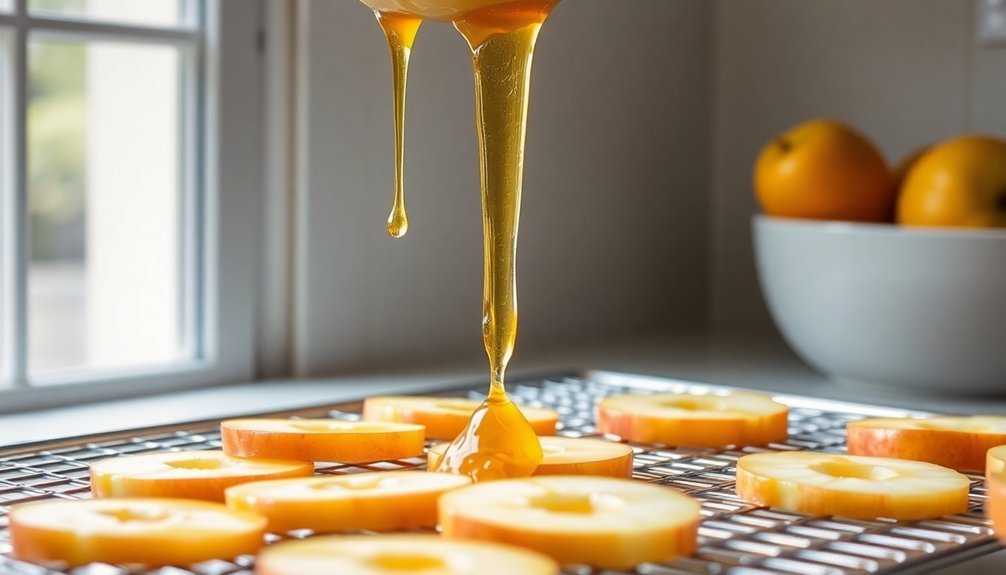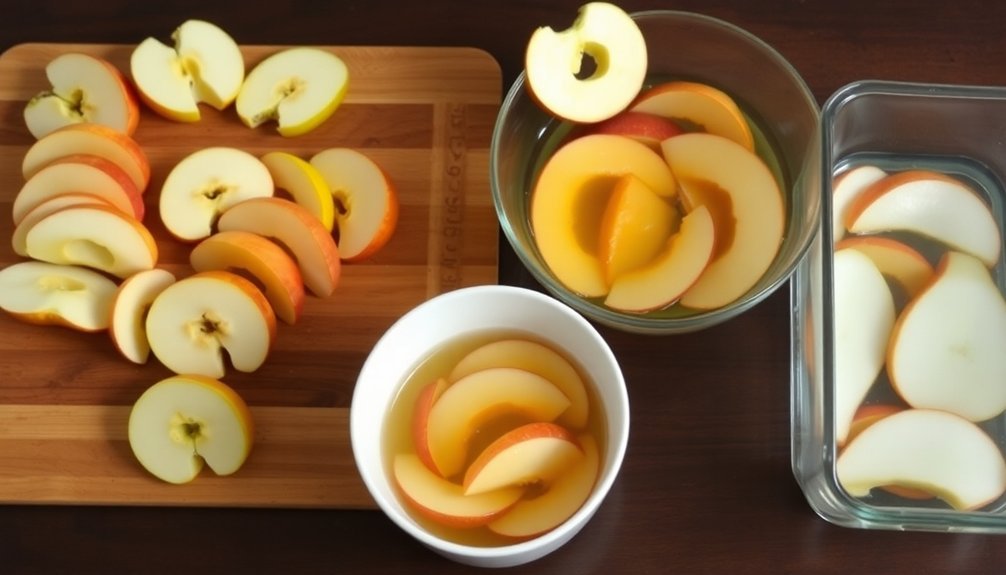Three proven pretreatments will help you achieve professional-quality dried fruits at home. Start with a natural vitamin C solution by mixing ascorbic acid powder with water, which prevents browning and preserves nutrients. You can also try steam blanching, using a pot with 1-2 inches of water and a tight-fitting lid, perfect for apples and apricots. For added sweetness, consider the honey dipping method by combining honey with lukewarm water and soaking your fruit slices for 3-5 minutes. These methods not only protect against bacteria but also enhance flavor and extend shelf life, opening up a world of dried fruit possibilities.
Natural Vitamin C Solutions

Two natural vitamin C solutions stand out as effective pretreatments for drying fruits: ascorbic acid solutions and fruit juice dips.
To make an ascorbic acid solution, you'll need to mix 1 teaspoon of powdered ascorbic acid (or 3000 mg of crushed tablets) with 2 cups of water. You can treat about 10 quarts of cut fruit with just one quart of this solution, and you can reuse it once before making a fresh batch.
If you don't have ascorbic acid on hand, you can use fruit juice dips as an alternative. Choose juices that are naturally high in vitamin C, such as lemon, orange, pineapple, grape, or cranberry. While these aren't as effective as pure ascorbic acid solutions, they'll add flavor and color to your dried fruit. Fresh, ripe fruits will yield better drying results when using these pretreatments.
For both methods, you'll want to soak your cut fruit for 3 to 5 minutes.
These vitamin C treatments offer multiple benefits: they prevent browning, fight harmful bacteria like E. coli and Salmonella, preserve nutrients during drying, maintain fruit color, and extend shelf life.
You'll find these pretreatments especially helpful when drying light-colored fruits that are prone to browning.
Steam Blanching Process
While vitamin C solutions work well for many fruits, steam blanching offers another effective pretreatment method.
You'll need to set up your equipment properly, starting with a large pot that has a tight-fitting lid or a double boiler. Place a steamer pan, wire basket, or colander inside to hold your fruit above the water, making sure it's not filled more than 2 inches deep with fruit. This method helps prevent nutrient loss compared to traditional water blanching.
Add 1-2 inches of water to the pot and bring it to a full boil before adding your fruit. Once you've placed the fruit in the steamer basket and replaced the lid, start your timer immediately.
You'll need to follow specific timing guidelines for different fruits – for example, apples need 3-5 minutes, while apricots require 3-4 minutes. During the process, you might want to check halfway through and stir if needed.
When the time's up, don't delay in removing your fruit from the heat. Cool it immediately under running water to stop the cooking process.
Before moving to your drying trays, pat the fruit dry with paper towels. Remember to spread the pieces evenly to guarantee proper drying.
Honey Dipping Method

One of the gentlest pretreatment methods for fruit drying is honey dipping, which combines honey with sugar water to create a protective coating.
You'll need to mix 1/2 cup of sugar with 1 1/2 cups of boiling water, let it cool until warm, then stir in 2/3 cup of honey. Alternatively, you can use 1/2 cup honey per quart of lukewarm water for a simpler solution. Natural sugars from honey provide an excellent energy source.
To apply the treatment, soak your fruit slices in the honey mixture for 3-5 minutes, then drain them thoroughly.
You'll want to place the treated fruit on drying racks sprayed with nonstick cooking spray to prevent sticking. Follow your dehydrator's specific instructions for drying times and temperatures.
This method's particularly beneficial if you're sensitive to sulfites, as it serves as a natural alternative.
The honey solution helps preserve color and flavor while increasing the fruit's sugar concentration, which extends shelf life.
You won't need to replace the dipping solution during processing, and the resulting dried fruit offers high calorie density – perfect for backpacking.
The treated fruit stores well when vacuum-packed and works excellently in various recipes or as a standalone snack.
Frequently Asked Questions
Can Different Pretreatments Be Combined for Better Results?
You shouldn't combine pretreatments, as it won't improve results and may be counterproductive. Single methods like ascorbic acid or lemon juice are effective enough on their own for your fruit drying needs.
How Long Can Pretreated Fruits Be Stored After Drying?
You'll find that properly pretreated and dried fruits can last 6-12 months in your pantry, 1-2 years in your refrigerator, or indefinitely in your freezer when stored in airtight containers.
Which Pretreatment Method Works Best for Specific Types of Fruits?
You'll want to use ascorbic acid for apples and berries, boiling water dip for grapes and cherries, sulfite dips for long-term storage fruits, and honey dips when you need better texture.
Does Room Temperature Affect the Effectiveness of Pretreatment Solutions?
Room temperature won't greatly affect your pretreatment solutions' effectiveness. Chemical and enzymatic treatments work well at normal room temps, though you'll want to avoid excessive heat that could degrade some chemical pretreatments over time.
Are There Alternatives for People With Allergies to Sulfites?
If you're allergic to sulfites, you can use ascorbic acid (vitamin C), citric acid solutions, or lemon juice as safe alternatives. They'll prevent fruit darkening and don't cause the allergic reactions that sulfites can trigger.
In Summary
You've now learned three effective pretreatment methods that'll help you create perfectly dried fruits at home. Whether you choose to use natural vitamin C solutions for light-colored fruits, steam blanching for firm varieties, or honey dipping for added sweetness, you'll get better results than drying untreated fruit. These methods prevent browning, maintain nutrients, and guarantee your dried fruits stay fresh longer.





Leave a Reply